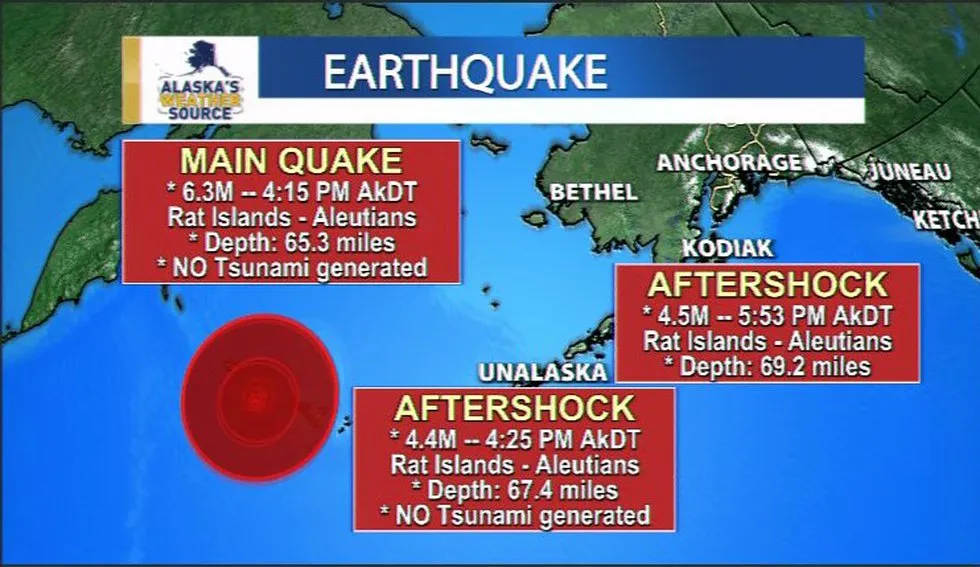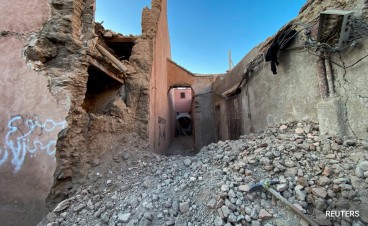Western Aleutians: Strong earthquakes were recorded

A 6.3- magnitude earthquake was recorded at 3:38 p.m. on Saturday about nine miles south of Davidof Island in the western Aleutians. Since that first quake, there have been five additional earthquakes in the area measuring a magnitude 2.9 and higher as of 7 p.m. Saturday.
Stephen Holtkamp, duty seismologist with the Alaska Earthquake Information Center, says this is a pretty typical sequence for this region.
“We can expect the aftershock sequence to continue for a few days,” said Holtkamp. He also said there is a low chance, about 3 to 5 percent, of a larger earthquake happening in the same area.
There has been no tsunami risk with these earthquakes. Holtkamp says these earthquakes are too deep to create a tsunami. “In order for a tsunami to be generated, it (an earthquake) needs to move the sea floor up and down,” said Holtkamp. “There’s 65 miles of rock between where the earthquake happened and the water,” Holtkamp said.
Davidof Island is in the Rat Islands. The first quake was recorded 36 miles southeast of Kiska Volcano and 55 miles west of Semisopochnoi Island.
Sources: alaskasnewssource.com, finax.in
Want to read more like this story?

11 strongest earthquakes worldwide over the last 2 centuries
Jul, 11, 2024 | NewsIt is estimated that at least 20,000 earthquakes occur every year worldwide due to the movement of...

The five strongest earthquakes ever recorded
Sep, 09, 2023 | NewsThe following lines describe five of the most devastating earthquakes in history: The Great Chile...

5.8-magnitude earthquake strikes Ecuador coast: damaged buildings, huge loss of property, no tsunami
Mar, 28, 2022 | NewsA huge loss of property was suffered when an earthquake of magnitude 5.8 struck Ecuador coast on Sa...

An 7.2-magnitude earthquake hits the Eastern Aleutian Islands.
Jul, 16, 2023 | NewsAn earthquake with a magnitude of 7.2 struck near the Eastern Aleutian Islands, raising concerns ab...

Earthquakes: five deadliest earthquakes ever recorded around the world
Feb, 24, 2022 | NewsEarthquakes are one of the most dangerous natural disasters. More than 100 earthquakes of the magni...

7.3-magnitude earthquake strikes near a remote Australian island
May, 19, 2022 | NewsA 7.3 magnitude earthquake has been recorded near a remote Australian island. The Bureau of Meteoro...

6.9-magnitude earthquake hit Kermadec Islands in New Zealand
Mar, 04, 2023 | NewsThe Kermadec Islands area of New Zealand was hit by an earthquake on Saturday with a magnitude of 6...

Messina earthquake (1908): a civil engineering landmark
May, 26, 2023 | EducationThe 1908 Messina earthquake, also known as the Great Reggio earthquake, is considered as one of t...

Iran: 425 earthquakes struck in one month
Mar, 13, 2024 | NewsAccording to the seismological networks of the Institute of Geophysics at the University of Tehran,...
Trending

Spectacular interchanges around the world

New Release - STAAD.Pro 2024 - 2

ADINA 2025 for Structural WorkSuite

ADINA 2025 New Release!

Concrete Buildings as Rechargeable Batteries

Powerful earthquake shakes central Philippines, dozens killed

Indonesia school collapse: three fatalities and dozens injured

